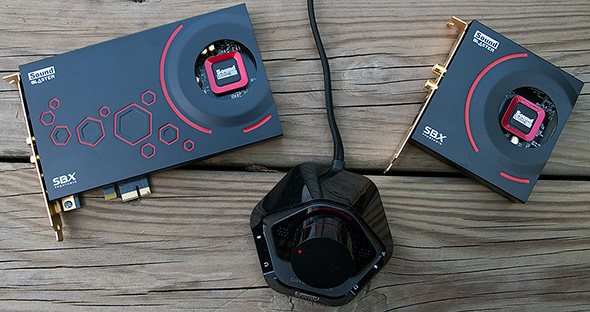Creative Sound Blaster ZxR Versus Onboard Audio
A Closer Look
Creative packs quite a few accessories in with its Sound Blaster ZxR bundle. We'll take a look at the base card, daughter card, and ACM module in a moment, but you should also find in the box a ribbon cable, mini jack to 1/4-inch adapters, an optical cable, male mini jack to dual RCA cable, driver disk, and paperwork.


The Sound Blaster ZxR is a two-card solution, though only the main card plugs into an available PCI-E slot. You still need an open expansion slot on the back of your computer case for the DBpro daughter board, you just won't plug it into a PCI-E port (or any other port). Instead, the two cards communicate with each other via an included ribbon cable.
There's a third main component of the Sound Blaster ZxR bundle, and that's the Audio Control Module (ACM). It boasts a built-in beamforming microphone array that does a capable job of picking up your voice as you move around. It also has microphone and headphone I/O connections, and a large volume knob.
Not all of Creative's past sound cards came with protective covers installed. The Sound Blaster ZxR and DBPro daughter board both do, but in addition to adding a stylish aesthetic and a bit of protection for the delicate components underneath, they also serve as EMI/RFI shields to prevent outside noise interference.
There's a third main component of the Sound Blaster ZxR bundle, and that's the Audio Control Module (ACM). It boasts a built-in beamforming microphone array that does a capable job of picking up your voice as you move around. It also has microphone and headphone I/O connections, and a large volume knob.
Not all of Creative's past sound cards came with protective covers installed. The Sound Blaster ZxR and DBPro daughter board both do, but in addition to adding a stylish aesthetic and a bit of protection for the delicate components underneath, they also serve as EMI/RFI shields to prevent outside noise interference.
 |
 |
Of course, we popped them off to take a peek at the printed circuit boards (PCBs) and various parts. If you look close, you can see a strip of metal that runs vertically across both cards -- these are also EMI shields erected in between the analog and digital sections to prevent any interference from one side to the other. This is part of the reason why Creative can get the signal-to-noise ratio up to 124dB.
Other noticeable parts including replaceable OP amps, high-quality capacitors, Burr-Brown Digital to Analog Converters (DACs), multi-layer PCBs, and the crown jewel of the Sound Blaster ZxR -- the Sound Core3D chip. This is where much of the musical magic happens, as the multi-core processor is tasked with processing audio and voice technologies. It's directly responsible for powering Creative's CrystalVoice technology and SBX Pro Studio. According to Creative, the Sound Core3D is the industry's first sound and voice processor to integrate an array of high-performance digital signal processor (DSP) cores and an HD audio codec on a single chip.
Much of what you're seeing here are billed as being "studio grade" or "professional quality," and we won't dispute either claim. As we mentioned earlier, the Sound Blaster ZxR is a serious sound card solution that goes beyond the realm of gaming and into musical content creation and playback. More on that later.

Other noticeable parts including replaceable OP amps, high-quality capacitors, Burr-Brown Digital to Analog Converters (DACs), multi-layer PCBs, and the crown jewel of the Sound Blaster ZxR -- the Sound Core3D chip. This is where much of the musical magic happens, as the multi-core processor is tasked with processing audio and voice technologies. It's directly responsible for powering Creative's CrystalVoice technology and SBX Pro Studio. According to Creative, the Sound Core3D is the industry's first sound and voice processor to integrate an array of high-performance digital signal processor (DSP) cores and an HD audio codec on a single chip.
Much of what you're seeing here are billed as being "studio grade" or "professional quality," and we won't dispute either claim. As we mentioned earlier, the Sound Blaster ZxR is a serious sound card solution that goes beyond the realm of gaming and into musical content creation and playback. More on that later.

This is where Creative brings home the gold -- in the plated connectors! Starting with the main audio card, here are the inputs you're looking at (going from top to bottom):
- 6.3mm Microphone In jack: Connects to microphones with a 6.3mm (1/4-inch) plug.
- 6.3mm Headphone jack: Connects to stereo headphones with a 6.3mm (1/4-inch) plug.
- RCA Line Out 1 jack (Front L): Connects to the Front Left inputs on powered analog speakers or an A/V receiver.
- RCA Line Out 2 jack (Front R): Connects to the Front Right inputs on powered analog speakers or an A/V receiver.
- 3.5mm Line Out 1 jack (Rear L/R): connects to the Rear Left and Rear Right inputs on powered analog speakers or an A/V receiver.
- 3.5mm Line Out 2 jack (Center/Subwoofer): Connects to the Center and Subwoofer inputs on powered analog speakers or an A/V receiver.
And on the DBpro Daught Board (also from top to bottom):
- RCA Aux-In 1 jack (L): Connects to the Left output line-level sources (for example, MP3 players) with an RCA plug.
- RCA Aux-In 2 jack (R): Connects to the Right output line-level sources (for example, MPG players) with an RCA plug.
- Optical S/PDIF Out jack: Connects to recording devices with optical connectors (for example, Digital Audio Tape recorders, MiniDisc recorders, or external hard disk recorders).
- Optical S/PDIF In jack: Connects to playback devices with optical connectors (for example, Digital Audio Tape recorders, MiniDisc recorders, or external hard disk recorders).
Savvy? Let's dive into our test setup and various software accoutrements.






